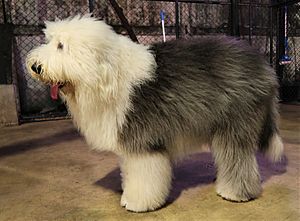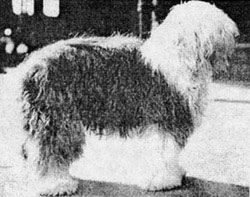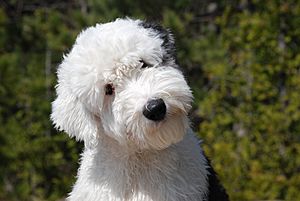Old English Sheepdog facts for kids
Quick facts for kids Old English Sheepdog |
||||||||||||||||||||||||||
|---|---|---|---|---|---|---|---|---|---|---|---|---|---|---|---|---|---|---|---|---|---|---|---|---|---|---|

A show-standard Old English Sheepdog
|
||||||||||||||||||||||||||
| Origin | England | |||||||||||||||||||||||||
|
||||||||||||||||||||||||||
| Domestic dog (Canis lupus familiaris) | ||||||||||||||||||||||||||
The Old English Sheepdog (OES) is a large dog breed. It came from early herding dogs in England. Some old names for this breed are "Shepherd's Dog" and "bob-tailed sheep-dog".
They are often called "Bob-tail" because their tails used to be shortened. This practice is called docking. Old English Sheepdogs have very long, shaggy coats. Their fur can cover their faces and eyes. They only shed their fur when they are brushed.
Contents
What Old English Sheepdogs Look Like
The Old English Sheepdog is a large dog. You can easily spot it by its long, thick, shaggy grey and white coat. Its fur often covers its face and eyes. Their ears lie flat against their head.
Historically, their tails were often docked. This made their rear end look a bit like a giant panda. However, many countries have now made cosmetic docking illegal. So, it's common to see Old English Sheepdogs with their tails today. When they have a tail, it's long and furry, hanging low.
An Old English Sheepdog stands lower at its shoulders than at its hips. It walks with a special "bear-like roll" from its back end.
Size and Weight
Male Old English Sheepdogs are usually at least 61 centimeters (24 inches) tall. Females are a little smaller. Their bodies are short and strong. Large males can weigh up to 46 kilograms (101 pounds).
Coat Colors
Their double coat can be many shades of grey. This includes grizzle, black, blue, or blue merle. They can also have white markings. The undercoat is good at keeping water out.
Puppies are born with black and white fur. The more common grey or silver shaggy hair appears after their puppy coat falls out. Remember, Old English Sheepdogs only shed their fur when they are brushed.
History of the Breed
The Old English Sheepdog comes from herding dogs in England. Some people think a small dog in a 1771 painting looks like an early Old English Sheepdog. This painting was done by Gainsborough.
In the early 1800s, a bobtailed drover's dog was seen in southwestern England. This dog was called the Smithfield or Cotswold Cor. It might have been an ancestor of today's breed. Many experts believe the Bearded Collie was used to help create the Old English Sheepdog. Some also think the Russian Owtchar might be an ancestor.
The Old English Sheepdog was first called the "Shepherd's Dog." It was shown for the first time at a dog show in Birmingham, England, in 1873. Only three dogs were entered. The judge thought they were not very good, so he only gave a second-place prize.
After this start, the breed became a popular show dog. The dog's shape has not changed much over the years. But, people started to groom them in fancy ways. This included backcombing and powdering their fur as early as 1907. The breed was brought to the United States in the 1880s. By the early 1900s, five of the richest American families owned and showed Old English Sheepdogs. They are still popular show dogs today.
Health and Lifespan
Surveys in the US and UK show that Old English Sheepdogs usually live for 10 to 11 years.
Temperament and Personality
Old English Sheepdogs are described as never being nervous or aggressive. The New Zealand Kennel Club says they can sometimes be "couch potatoes." They might even try to herd children by gently bumping them.
This breed is known for being smart, social, and able to adapt to different situations. The American Kennel Club adds that they have a "clownish energy." They might try to herd people or other objects.
Old English Sheepdogs are a great fit for a farm or rural area. This is because they love wide open spaces. But, with enough exercise and training, they can also live happily in suburban or city homes. Old English Sheepdogs need to be around people and feel their warmth.
Fun Activities for Old English Sheepdogs
Old English Sheepdogs can do many fun activities. They can compete in dog agility trials, where they run through obstacle courses. They also do well in obedience and Rally obedience competitions. These events test how well they listen to commands.
They can also take part in Schutzhund, showmanship, and flyball. Flyball is a team sport where dogs race over hurdles to get a ball. They can also do tracking and herding events. Herding tests show if a dog has natural herding instincts. Dogs with these instincts can be trained for herding trials.
Taking Care of Their Coat
The Old English Sheepdog's long coat needs a lot of care. You should brush it thoroughly at least once a week. This can take one to three hours. If you don't brush them regularly, their coat can become dirty. It can trap dust, debris, and moisture.
Matted fur can be painful for the dog. It can even stop them from moving properly in severe cases. People who want an Old English Sheepdog should know about this grooming need.
The best way to brush their coat is to start from the base of the hairs. This helps keep the thick undercoat free of mats and tangles. You should start brushing them when they are very young. This helps the dog get used to it. You can use a hairband to keep their fur out of their eyes. Many owners choose to trim their dogs' coats shorter. This makes it easier to manage. An electric shear can save a lot of time. However, dogs that are shown in dog shows must keep their natural long coat.
Some people even shave their Sheepdog's hair. They then spin it into yarn.
The Dulux Dog
The Old English Sheepdog is the famous mascot for Dulux paint. The dog first appeared in Australian advertisements in the 1960s. Since then, they have been a popular part of Dulux TV and print ads. This is true in Australia, South Africa, and the UK. People in these places often call the breed a "Dulux dog."
Over the years, different dogs have been used in the ads. They all look very similar. Most of them come from a closely related line of pedigree dogs. The first Dulux dog was named Shepton Dash. He had the role for eight years.
His successor was Fernville Lord Digby. He was the most famous Dulux dog. He also made his owner, Cynthia Harrison, well-known. When filming commercials, Digby was treated like a star. He even had a chauffeur to drive him to the studio. A famous dog trainer, Barbara Woodhouse, trained Digby. She also trained his three stunt doubles. These stunt doubles were used for special tricks or actions.
Except for Dash, all the Dulux dogs have been champions. Five of them have won 'Best of Show' prizes. The most recent Dulux Dog, named Don, is qualified for the Crufts dog show.
Famous Old English Sheepdogs in Pop Culture
Old English Sheepdogs have appeared in many movies, TV shows, and books. Here are some of them:
- Alfie in Serpico
- Annabell in Foofur
- Ambrosius in Labyrinth (1986 film)
- Bundles in The Shaggy Dog (1994)
- Barney in Barney (TV series)
- Barkley in Sesame Street
- Barry in The Tale of Edward
- Bebe in Captain Kangaroo
- "Big Dog" in 2 Stupid Dogs
- Boot in The Perishers
- Broo in The Raccoons
- Chiffon in The Shaggy Dog (1959)
- Colonel in One Hundred and One Dalmatians
- Cu in Song of the Sea
- Jerry in 101 Dalmatians II: Patch's London Adventure
- Digby in Digby, the Biggest Dog in the World
- Drooler in Krypto the Superdog
- Edison in Chitty Chitty Bang Bang
- Elwood in The Shaggy D.A.
- Lad in "Please don't eat the daisies"
- Lat in The Brady Bunch
- Farley in For Better or For Worse
- Hot Dog in Archie Comics
- Martha, Paul McCartney's Old English Sheepdog, was said to be the namesake of his song "Martha My Dear".
- Max in The Little Mermaid and The Little Mermaid II: Return to the Sea
- Mr. Mugs
- Mooch in Lady and the Tramp II: Scamp's Adventure
- Muffin Mclay in Hairy Maclary from Donaldson's Dairy, a children's picture book series
- Nana in Hook (film)
- Nate in Open Season 3
- Niblet, Giblet, and Rebound on Pound Puppies
- Presley on Andrew in New York
- Sam in Cats & Dogs and Cats & Dogs: The Revenge of Kitty Galore
- Samson in Samson en Gert (TV series)
- Shag in Road Rovers
- Schaeffer in The Raccoons
- Tiger in The Patty Duke Show
- Wordsworth in Jamie and the Magic Torch
See also
 In Spanish: Bobtail para niños
In Spanish: Bobtail para niños



